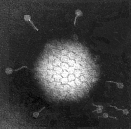



Adenoviruses are naked dsDNA viruses with an icosahedral capsid
and noticeable protein spikes. They utilize an Ig superfamily receptor commonly found on mucoepithelial cells
to infect host cells and therefore primarily target the respiratory and GI tract
epithelium as well as the conjunctiva. Transmission is oral-fecal and direct
contact. Adenoviruses resist drying, chlorine, and stomach acids.
They utilize an Ig superfamily receptor commonly found on mucoepithelial cells
to infect host cells and therefore primarily target the respiratory and GI tract
epithelium as well as the conjunctiva. Transmission is oral-fecal and direct
contact. Adenoviruses resist drying, chlorine, and stomach acids.
Symptoms of infection range from cold-like to acute (pertussis-like and pneumonia). Cough, sore throat, nasal congestion and runny nose are common. Fever, chills, and muscle aches (myalgia) may be seen. Often cold-like symptoms occur along with pink eye. Outbreaks are usually associated with military personnel (Serotypes 4 & 7).
Adenoviruses are a major cause of viral gastroenteritis and infantile diarrhea. Fever is rarely seen with these infections. Serotypes 40 & 42
Inflammation of the conjunctiva of both eyes. Often transmitted in swimming pools.
Complications in immunocompromised individuals
Antibody mediated response plus interferon-limited spread. Immunity is short-term. A live vaccine is available for 2 strains of adenovirus.